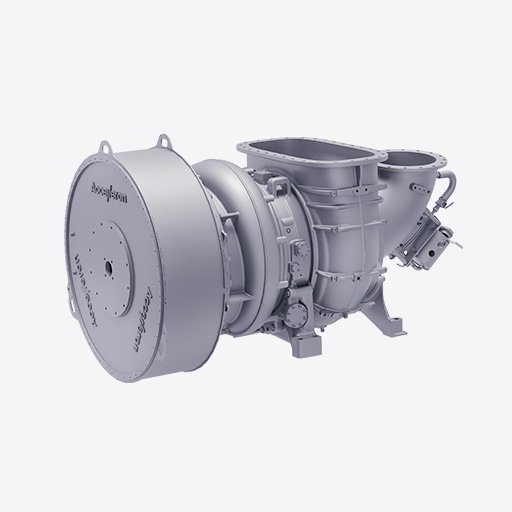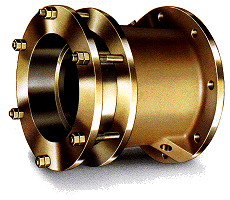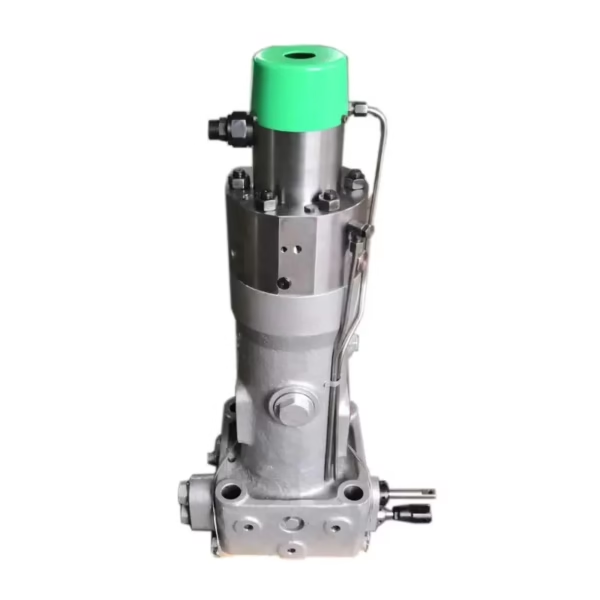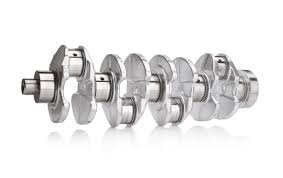A marine engine turbocharger is a forced induction device that uses the engine’s waste exhaust gas energy to compress intake air.1 By forcing more air into the cylinders, it allows for a more complete combustion, significantly increasing the engine’s power output, efficiency, and reducing emissions.2
Function and Design
A turbocharger is essentially a pair of fans on a single shaft, operating on a waste heat recovery principle:3
- Turbine Side: Hot, high-velocity exhaust gases from the engine are directed to a turbine wheel.4 The gas expands through a nozzle ring, causing the turbine to spin at extremely high speeds (up to 150,000 RPM or more).5
- Compressor Side: A compressor wheel is mounted on the same shaft as the turbine.6 As the turbine rotates, it drives the compressor, which draws in fresh air from the atmosphere, compresses it, and increases its pressure and temperature.7
- Charge Air Cooler (Intercooler): The compressed air is then passed through an intercooler, which cools it down.8 This cooling process increases the air density, allowing even more oxygen molecules to be packed into the cylinder for combustion.9
- Air Supply: The cooled, compressed air is then fed into the engine’s intake manifold (scavenge air receiver), ready to be mixed with fuel.10
Key components of a turbocharger include:
- Turbine and Compressor Wheels: The rotating elements.11
- Common Shaft: Connects the two wheels.12
- Bearing System: Supports the high-speed shaft, typically using plain bearings with a pressurized oil film.
- Casing/Housing: Separate housings for the turbine and compressor, often with water-cooling jackets on the turbine side to manage heat.
Challenges and Maintenance
Turbochargers operate under some of the most demanding conditions in an engine, facing:
- Extreme Speeds: High rotational speeds generate immense centrifugal forces and require a robust bearing system.13
- High Temperatures: The turbine side is exposed to exhaust gases often exceeding 500°C.
- Vibration and Imbalance: Rotor imbalance from deposits or damage can lead to severe vibration and bearing failure.14
Critical maintenance and monitoring practices are essential:
- Regular Cleaning: Deposits (soot on the turbine side, oil and dust on the compressor side) are a primary concern.15 They cause rotor imbalance, reduced efficiency, and can lead to damage. Water washing or grit blasting are common cleaning methods.16
- Bearing Condition: The health of the bearing system is vital.17 Low oil pressure, contaminated oil, or shaft imbalance can cause bearing failure, leading to catastrophic turbocharger and engine damage.
- Performance Monitoring: Key parameters like exhaust gas temperature and charge air pressure (boost pressure) are monitored.18 A drop in boost or an increase in exhaust temperature can indicate a dirty or failing turbocharger.19
- Surging: A phenomenon where the compressor cannot maintain a stable airflow, leading to pressure fluctuations, loud noises, and potential damage.20 It can be caused by a dirty turbo, improper engine operation, or a blocked air filter.
- Inspections: Periodic overhauls and inspections are necessary to check for cracks, erosion, foreign object damage (FOD), or signs of wear on the turbine and compressor wheels and the casing.21
The turbocharger is a highly sensitive and expensive component. Proactive maintenance, adherence to manufacturer specifications, and careful monitoring of engine performance are crucial for its longevity and for the overall efficiency and power of the marine engine.22
We offer an extensive range of marine engine brands and their associated spare parts, providing comprehensive solutions for both main propulsion and auxiliary power needs across diverse vessel types. Our supply capability covers various generations and models, ensuring support for a wide array of marine applications.
Featured Brands and Engine Series/Models:
SULZER:
- Two-Stroke Engines:
- RD/RND Series: RD68, RND76, RND76M, RND90, RND90M (Classic large-bore, low-speed engines, still in operation).
- RLA/RLB Series: RLA(B)56, RLA(B)66, RLA(B)76, RLB90 (Developed two-stroke designs).
- RTA/RT-Flex Series: RTA38, RTA48(T), RTA52, RTA58, RTA62, RTA72, RTA76, RTA84, RTA84M, RTA84C, RTA96 (Modern, fuel-efficient, electronically controlled two-stroke engines).
- Four-Stroke Engines:
- Z Series: ZL40/48, 16ZAV40S (Medium-speed engines).
- RF Series: RF44, RF56 (Often used for auxiliary power or generator sets).
- TAD Series: TAD36, TAD48 (For specific applications).
MAN (including pre and post-MAN B&W models):
- Two-Stroke Engines (KZ, KSZ, K, L, S, MC/MC-C, ME/ME-C): 40/54A, 52/90N, 57/80C, KZ57/80F, KSZ70/125, KSZ78/155, 90/160A, 52/55L, 58/64, 90/190C, L60/105E, 70/120E, 70/125C, L, KSZ78/155A, KSZ70/125B, L52/55A, 40/45 (A broad spectrum covering main propulsion and auxiliary engines).
B&W (Burmeister & Wain – prior to MAN B&W merger):
- MC/MCE Series: L35MC, L60MC, L80MC, L55GFCA, L80GFCA, L80GB, 74VT2BF, K62EF, K74EF, K84EF, K45GFC, K67GFK, K80GFK, K90GFS, 45HU, L70MC (Various generations of two-stroke diesel engines).
- MC-C/ME-C Series: L50MC, S60MC, S70MC, K80MC, S80MC, K90MC-C, L67GFCA, L90GB (Electronically controlled and conventional two-stroke engines).
- VT2BF/EF Series: 50VT2BF, 62VT2BF, K84EF (Older models still in service).
MITSUBISHI:
- UEC/UET Series: UEC37L/LA/LS, UEC45HA, UEC60L/LA/LS, UEC45L/LA/LS, UET45/75C, UEC52/125H, UEC52L/LA/LS, UET45/80D, UEC52/90D, UEC(T)52/105D, UEC45/115H, UEC37/88H, UEC37H (Mitsubishi’s proprietary two-stroke and some four-stroke engine series).
PIELSTICK:
- PA Series: PA6, PC3, PC2-2, IHI PC2-5, PC4, PC2-6, PC4-2L, PC4-570, PA5 (High-speed, compact four-stroke engines, commonly used for generator sets or auxiliary propulsion).
AKASAKA:
- UET/UEC/DM/AH Series: UET45/80D, UEC52/105D, DM51SS, UEC 60/150H, UEC 60H, A31, A34, A37, A41, AH27, AH28, AH30, AH36, AH38, AH40, DM30, DM36, DM38, DM46, DM47 (A prevalent engine brand, particularly in Japanese-built vessels).
DEUTZ:
- RBV/TBD/BVM Series: RBV8M358, RBV8M540, RBV16M640, TBD620L6, BVM350, BVM540, BF6M716 (Various four-stroke medium- and high-speed diesel engines for auxiliary and smaller main propulsion applications).
HANSHIN:
- EL/LH/LU/LUN/LUD/LUS Series: EL30, EL32, EL35, EL40, EL44, LH28RG, LH31G, LU28(A,R,G), LU32, LU35, LU38, LU46(A), LU50, LU54, LUN28, LUN30, LUD32, LUD35, LUS38 (Another significant engine brand commonly found in Japanese vessels).
NIIGATA:
- MG/M Series: MG40X(EX), M34X, 6M28BF, TM31X (Medium-speed diesel engines, typically used in small and medium-sized vessels).
MAK:
- M/MU/AK/AKM Series: M332, M453AK, MU551AK, MU552AK, M601, MU452AK, 451AK, 6M453AK, 9M453C, 6M601C, 8M601 (Medium-speed four-stroke engines, widely used in various marine applications).
WARTSILA:
- 20/22/26/32/38/46/GD/TKR Series: 22, 32, 31, 26, 20S, 28, 38, 46, 32GD, 46GD, 14, TKR22, HFR-V32, NOHAB (Wärtsilä’s broad portfolio of medium- and high-speed diesel engines for main propulsion, auxiliary, and generator sets).
DAIHATSU:
- PS/PKT/DS/DL/DK/PL Series: PS-18, PS-22, PS-20, PS-26, PS-30, PKT-14, PKT-16, PKTD-16, DS-18, DS-22, DS-26, DS-28, DS-32, DL-14, DL-16, DL-19, DL-20, DL-22, DL-24, DL-26, DK-20, PL-24 (Compact and reliable engines primarily used for auxiliary power and generator sets).
CUMMINS:
- BT/CT/NT/KTA/QSK/QSM Series: 4BT3.9, 6BT(A)5.9, 6CT8.3, NT(A)855, N14, KTA19, KTA38, KTA50, QSK19, QSM11 (Robust and durable engines for marine auxiliary power, generator sets, and some smaller main propulsion applications).
CATERPILLAR:
- 3000/3100/3300/3400/3500/3600 Series & C Series: 3054, 3056, 3066, 3106, 3126, 3306, 3406, 3408, 3412, 3508, 3512, 3516, 3606, 3608, 3612, 3616, 3618, C1.5, C2.2, C7, C9, C10, C12, C15, C16, C18, C30, C32 (Reliable and widely used engines across a vast range of main propulsion, auxiliary, and generator set applications).
SCANIA:
- DI Series: DI 09, DI 13, DI 16 (High-performance diesel engines designed for marine applications, typically used as auxiliary and smaller main propulsion engines).




